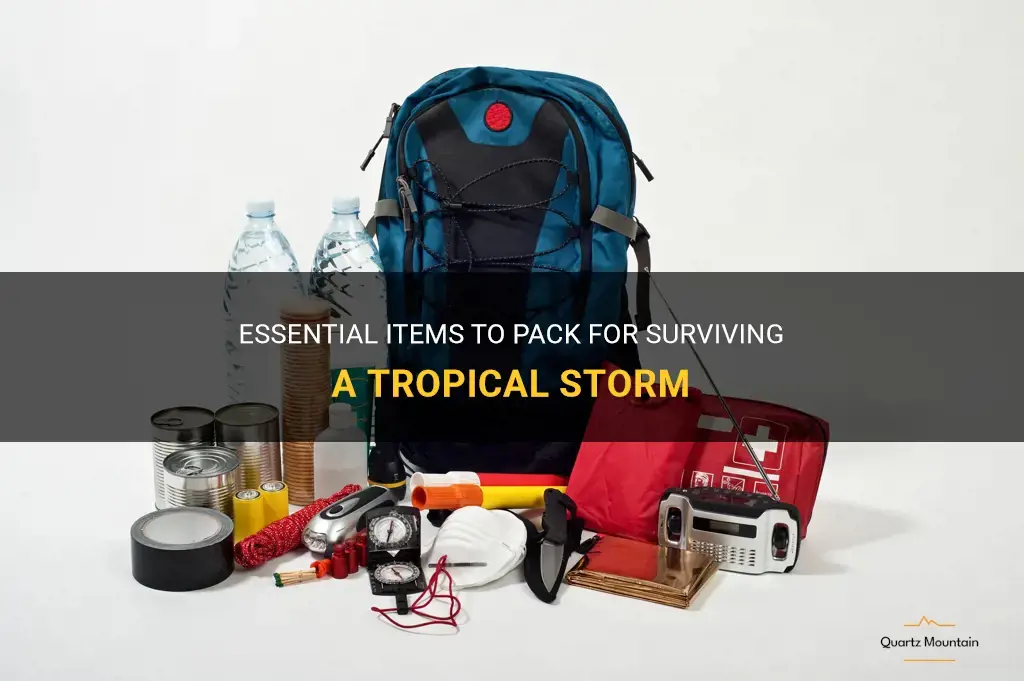
Tropical storms are powerful and unpredictable natural phenomena that can wreak havoc on coastal communities. When facing the possibility of such a storm, being prepared is crucial for your safety and survival. One important aspect of preparedness is knowing what essential items to pack. From durable shelter to reliable communication devices, this article will guide you through the must-have items that will help you weather the storm and navigate the aftermath. Don't wait until it's too late; start packing today to ensure your survival in the face of a tropical storm.
What You'll Learn
- What essential items should be included in a tropical storm emergency kit?
- How much water should I pack per person for a tropical storm?
- Are there any specific clothing items that should be packed for a tropical storm?
- Should I include any particular food items in my emergency kit for a tropical storm?
- What other important items should be included in a tropical storm emergency kit, aside from the basic necessities?

What essential items should be included in a tropical storm emergency kit?
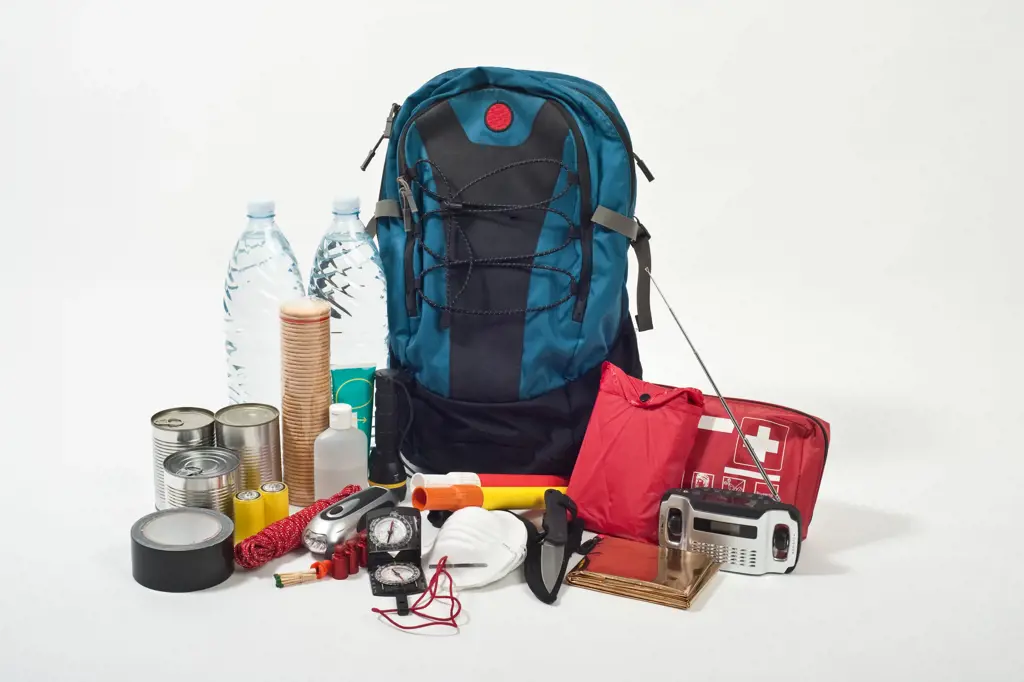
A tropical storm can bring with it heavy rains, high winds, and flooding, which can lead to power outages and other emergencies. It is crucial to be prepared for such situations by having an emergency kit ready. This kit should include essential items that can help you and your family stay safe and comfortable during the storm. Here are some items that should be included in a tropical storm emergency kit:
- Water - It is essential to have enough clean drinking water for each family member. The recommended amount is one gallon per person per day, for at least three days. Store water in clean, sealed containers.
- Non-perishable food - Stock up on non-perishable food items such as canned goods, dried fruits, nuts, and granola bars. Make sure to have enough food for each family member for at least three days.
- Flashlights and batteries - Power outages are common during tropical storms, so having flashlights with extra batteries is crucial. LED flashlights are recommended as they have a longer battery life.
- First aid kit - A well-stocked first aid kit is essential in case of injuries or medical emergencies. Make sure your kit includes bandages, antiseptic ointment, pain relievers, and any prescription medications.
- Battery-powered or hand-crank radio - During a tropical storm, it is important to stay informed about weather updates and emergency announcements. A battery-powered or hand-crank radio can help you stay connected to the outside world.
- Personal hygiene products - Pack essential personal hygiene items such as toilet paper, wet wipes, hand sanitizer, and feminine hygiene products.
- Extra clothing and blankets - It is important to have spare clothing and blankets to keep you warm and dry in case of power outages or damage to your home.
- Emergency cash - In the event of power outages, ATMs and credit card machines may not work. It is a good idea to have some emergency cash on hand to purchase essential items if needed.
- Important documents - Keep important documents such as identification papers, insurance policies, and contact information in a waterproof container. This will ensure that you have access to important information in case of damage to your home.
- Tools and supplies - Include a toolkit with essential tools such as a wrench, pliers, and a multi-purpose knife. Also, pack extra batteries, duct tape, rope, and plastic sheeting for emergency repairs.
- Pet supplies - If you have pets, don't forget to include their necessities in your emergency kit. This may include food, water, medications, and a leash.
- Entertainment items - Being stuck inside during a tropical storm can be stressful and boring. Include items such as books, board games, and playing cards to keep everyone entertained.
Remember to regularly check and replace expired items in your emergency kit. Additionally, it is important to have an emergency plan in place and to stay informed about weather updates and evacuation orders issued by local authorities. By being prepared and having an emergency kit ready, you can ensure the safety and comfort of your family during a tropical storm.
The Ultimate Checklist for Packing for a 9-Day Cruise [PDF Included!]
You may want to see also

How much water should I pack per person for a tropical storm?
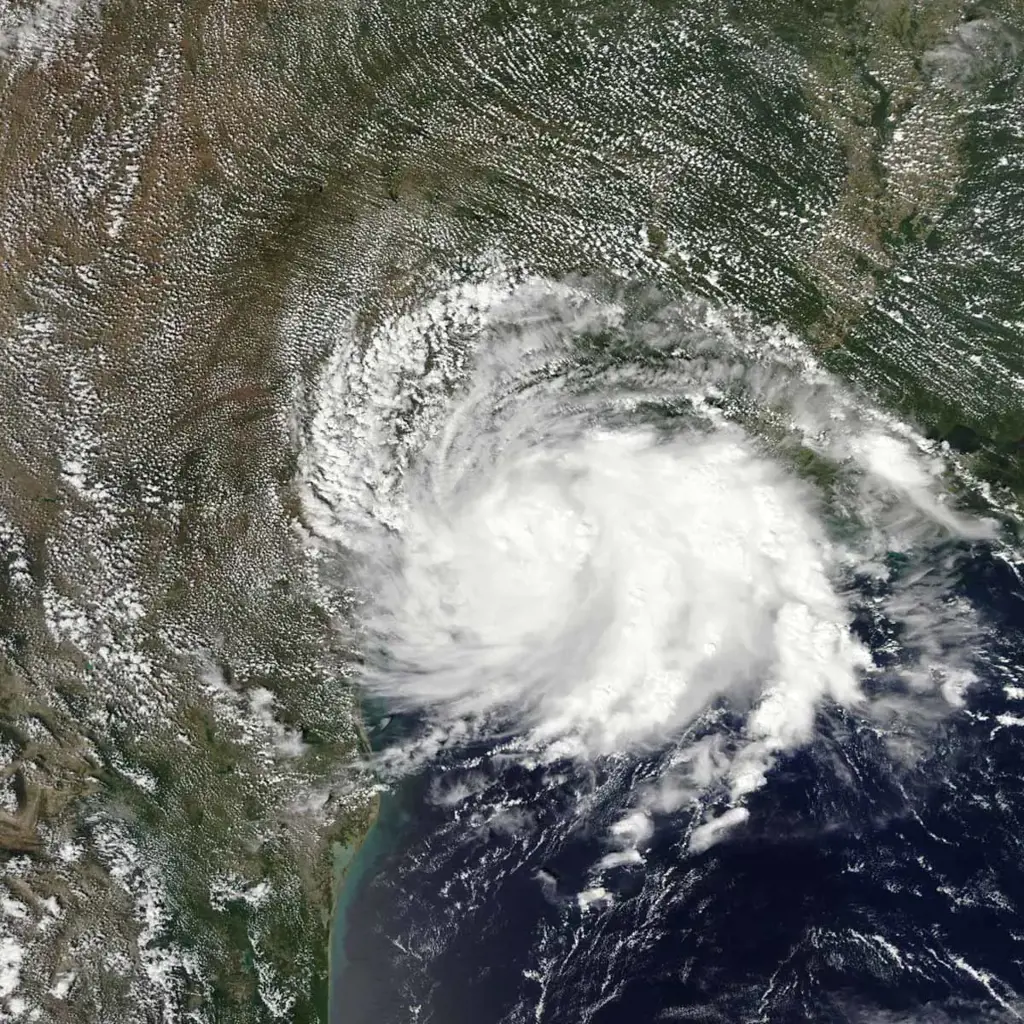
When preparing for a tropical storm, one of the most important things to consider is how much water to pack per person. Water is essential for survival, and in the event of a tropical storm, clean and safe drinking water may not be readily available. It is crucial to plan ahead and ensure you have enough water to sustain yourself and your family until assistance arrives or until normal water sources are restored.
The general rule of thumb is to pack at least one gallon of water per person per day. This is just for drinking and does not take into account other needs such as cooking, hygiene, and pets. Additionally, it is important to have enough water for a minimum of three days, as it may take some time for services to be restored after a tropical storm.
However, in certain situations, such as extreme heat or if you have medical conditions that require more hydration, you may need to pack more than one gallon per person per day. It is always better to err on the side of caution and have extra water, rather than risking dehydration during an emergency.
In order to calculate how much water you should pack per person, consider the following factors:
- Number of people: Start by determining how many people will be relying on the stored water. This includes everyone in your household, including children and pets.
- Duration of the storm: Estimate how long the tropical storm is expected to last. It is recommended to have enough water to last for at least three days, but it's best to have more if possible.
- Additional needs: Consider any additional factors that may increase the amount of water needed. This includes individuals with medical conditions, pregnant women, and nursing mothers. It is also important to account for pets and their hydration needs.
- Climate and environmental conditions: If you live in a hot and humid climate, you will need to increase your water supply. The same goes for areas that may not have access to clean drinking water as quickly after the storm.
- Stored water sources: If you have access to additional water sources, such as rainwater collection systems or nearby bodies of water, you can use these to supplement your stored supply. However, it is important to treat and purify this water before consuming it.
To give you a better idea of how much water you should pack per person, here are a few examples:
Example 1: A family of four living in a moderate climate with no specific medical conditions or hydration needs. They estimate the tropical storm will last around five days. In this case, they would need a minimum of 20 gallons of water (4 people x 1 gallon per day x 5 days).
Example 2: A couple with a newborn baby living in a hot and humid climate. They estimate the tropical storm will last around three days. They would need a minimum of 9 gallons of water (3 people x 1.5 gallons per day x 3 days). Additionally, they may want to have some extra water for the baby's bottle preparation and hygiene needs.
Remember, it is important to store the water in sturdy containers that are specifically designed for long-term storage. It is also recommended to rotate your water supply every six months to ensure freshness and prevent bacterial growth.
In conclusion, when preparing for a tropical storm, it is crucial to pack enough water per person to ensure hydration and survival. The general guideline is to pack at least one gallon of water per person per day, but this can vary depending on factors such as climate, duration of the storm, and individual needs. It is always better to have too much water than not enough, so plan ahead and store an adequate supply to keep you and your loved ones safe during a tropical storm.

Are there any specific clothing items that should be packed for a tropical storm?

When preparing for a tropical storm, it is important to pack specific clothing items that will help protect you from the elements and keep you comfortable in the unpredictable weather conditions. Here are some clothing items that you should consider packing:
- Rain jacket or poncho: A waterproof rain jacket or poncho is essential to keep you dry during heavy rain showers. Look for one that is lightweight and breathable so you don't overheat.
- Quick-drying shorts or pants: Opt for quick-drying shorts or pants made from moisture-wicking materials. These will help keep you cool and dry if you need to wade through water or encounter heavy rainfall.
- Long-sleeve shirts: Packing a few lightweight, long-sleeve shirts is a good idea to protect your arms from sunburn and insect bites. Look for shirts that have UV protection and are made from lightweight, breathable fabrics.
- Hat with a brim: A hat with a brim is essential to protect your face and head from the sun. Choose a hat that is lightweight and made from breathable materials to ensure comfort.
- Waterproof shoes or sandals: It is important to have waterproof shoes or sandals to keep your feet dry during a tropical storm. Look for shoes that have a good grip to prevent slipping on wet surfaces.
- Extra socks: Pack extra pairs of socks to ensure you have dry feet throughout the storm. Opt for moisture-wicking socks made from synthetic materials to prevent blisters and keep your feet comfortable.
- Swimsuit: Even during a tropical storm, there may be periods of clear weather or the opportunity to swim in a sheltered area. Packing a swimsuit allows you to take advantage of these opportunities.
- Lightweight cardigan or jacket: Even in tropical climates, evenings can sometimes be cooler or damp. Packing a lightweight cardigan or jacket will allow you to layer up if needed.
- Insect repellent clothing: Consider packing clothing that has been treated with insect repellent. This will help protect you from annoying and potentially harmful insect bites.
- Extra underwear: It is always a good idea to pack extra underwear during a tropical storm, as you may not have easy access to laundry facilities.
Remember to pack enough clothes for the duration of the storm, as well as a few extra days in case of any unforeseen circumstances. It is also important to have a waterproof bag or backpack to keep your clothes dry during transit. By packing these specific clothing items, you will be well-prepared to face the elements and stay comfortable during a tropical storm.
Essential Items to Pack for Your Desert Adventure
You may want to see also

Should I include any particular food items in my emergency kit for a tropical storm?
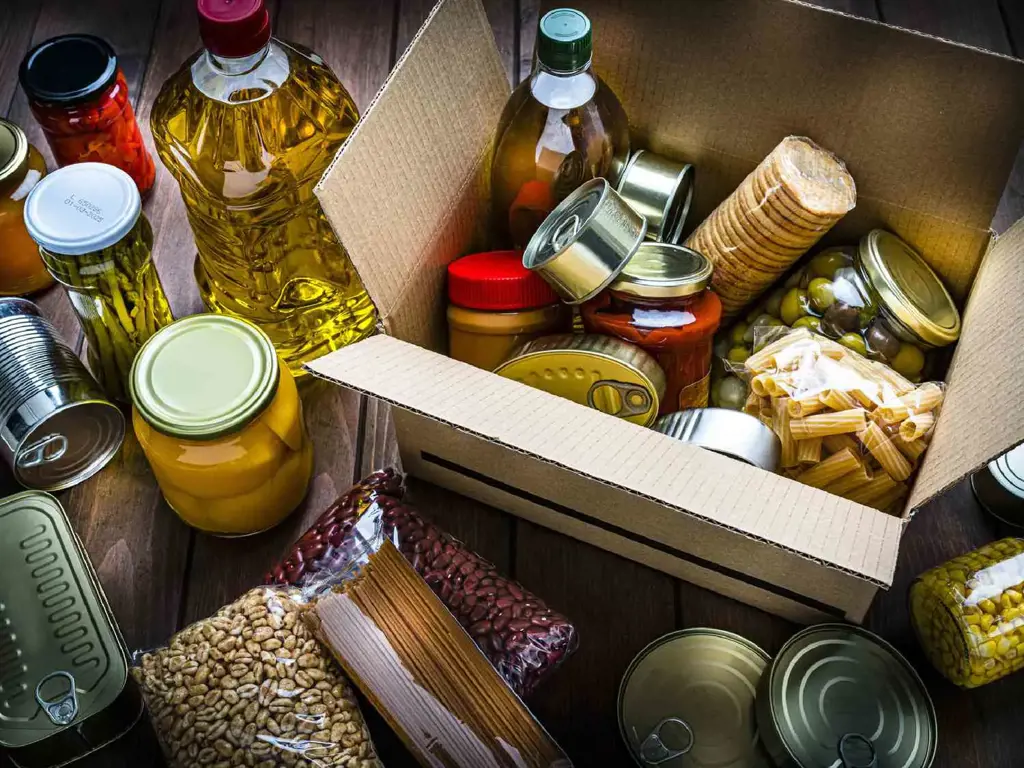
When preparing for a tropical storm, it is important to create an emergency kit that includes essential food items. Tropical storms can result in power outages and limited access to stores, making it crucial to have a supply of food that is non-perishable and easy to prepare. Here are some food items that should be included in your emergency kit for a tropical storm:
- Canned goods: Canned foods are an excellent choice for an emergency kit as they have a long shelf life and require minimal preparation. Be sure to include a variety of options such as canned vegetables, fruits, soups, and meats. These items provide essential nutrients and can be consumed cold or heated if a heat source is available.
- Dried fruits and nuts: Dried fruits and nuts are nutritious and have a long shelf life. They are a great source of energy and can be eaten as a snack or added to other food items. Make sure to choose varieties that do not require refrigeration.
- Protein bars: Protein bars are a convenient and compact source of nutrition. They are easy to store and can be eaten on the go. Look for options that are high in protein and low in sugar.
- Peanut butter: Peanut butter is an excellent source of protein and healthy fats. It is a versatile food item that can be spread on bread or crackers or used as a dip for fruits and vegetables. Choose a brand that does not require refrigeration.
- Crackers and rice cakes: Crackers and rice cakes are lightweight, easy to store, and have a long shelf life. They can be eaten on their own or used as a base for toppings such as peanut butter or canned meats.
- Instant noodles and soups: Instant noodles and soups are a quick and easy option for a warm meal during a tropical storm. They require minimal preparation and can be made with hot water if available. Look for options that come in single-serving packages.
- Water: While not a food item, water is crucial for survival during an emergency. Store enough water for each member of your household to last at least three days. It is recommended to have one gallon of water per person per day. Remember to replace the water in your emergency kit every six months.
When packing your emergency kit, it is important to consider the dietary needs and preferences of your household members. If anyone has specific dietary restrictions or allergies, be sure to include suitable alternatives. Additionally, consider including a manual can opener, disposable utensils, and paper plates for ease of use.
In conclusion, when preparing for a tropical storm, it is vital to include specific food items in your emergency kit. Canned goods, dried fruits and nuts, protein bars, peanut butter, crackers and rice cakes, instant noodles and soups, and water are all essential items to have on hand. By planning ahead and including these food items, you can ensure that you and your family will have access to nutritious and easily prepared meals during a tropical storm.
Essential Beach Vacation Packing Checklist for a 5-Day Trip
You may want to see also

What other important items should be included in a tropical storm emergency kit, aside from the basic necessities?
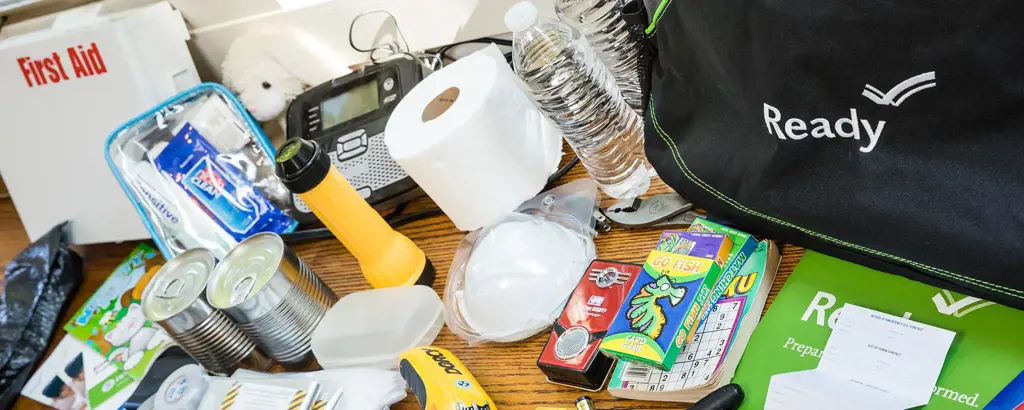
A tropical storm emergency kit is essential to have in areas prone to tropical storms and hurricanes. While the basic necessities such as food, water, and medication are undoubtedly important, there are other items that should also be included to ensure your safety and well-being during and after a tropical storm. Here are some additional items to consider including in your emergency kit:
- Batteries and a portable charger: Power outages are common during tropical storms, so having extra batteries for flashlights and a portable charger for your electronic devices can be crucial. This will allow you to stay connected, access important information, and communicate with loved ones during the storm.
- Personal documents: It is essential to have copies of important personal documents such as identification cards, passports, insurance policies, and medical records. Store them in a waterproof and portable container to keep them safe from water damage. These documents may be needed for identification or insurance claims after the storm.
- Cash and coins: ATMs and credit card systems may not be functional during a storm or in its aftermath. It is advisable to have some cash and coins on hand to be able to purchase necessities or pay for services that may be available despite the power outage.
- First aid kit: Injuries and accidents can occur during a storm, so having a well-stocked first aid kit is crucial. Include items such as bandages, antiseptic ointment, pain relievers, and any necessary prescription medications you or your family members may need.
- Tools and supplies: Having basic tools and supplies can be helpful in the event of damage to your property. Include items like a manual can opener, a multipurpose tool, duct tape, plastic tarps, and rope. These items can be used for repairs or temporary fixes until professional help arrives.
- Sanitary supplies: Proper hygiene is important during and after a tropical storm. Include items like hand sanitizer, wet wipes, toilet paper, and feminine hygiene products in your emergency kit.
- Extra clothing and blankets: It is important to have extra clothing and blankets in case your home becomes damaged or uninhabitable. Include warm clothing, rain gear, and blankets to ensure you stay warm and dry if you need to evacuate or seek shelter elsewhere.
- Important contact information: Keep a list of important contact information, such as emergency services, local authorities, utility companies, and family members. Include both local and out-of-area contacts to ensure you can reach someone in case local communication networks are down.
- Non-perishable food: While food is considered a basic necessity, it is worth mentioning that non-perishable food items should be included in your emergency kit. Choose foods that require little to no cooking or refrigeration, such as canned goods, granola bars, and dried fruits. Don't forget to include a manual can opener if necessary.
- Entertainment and comfort items: Tropical storms can lead to extended periods of confinement indoors. Include items such as books, board games, playing cards, and a favorite stuffed animal for children to provide comfort and entertainment during this time.
Remember to check and replenish your emergency kit regularly to ensure that all items are in good condition and up to date. Having these additional items in your tropical storm emergency kit will help ensure your safety and comfort during a storm and its aftermath. Stay prepared and stay safe!
The Ultimate Guide to Packing for an 11-Day Cruise on the Great Lakes
You may want to see also
Frequently asked questions
When packing for a tropical storm, it is important to include essential items such as a first aid kit, medications, a flashlight, extra batteries, a portable phone charger, non-perishable food, and bottled water. Additionally, you should pack a change of clothes, sturdy shoes, blankets or sleeping bags, and personal hygiene products. It is also recommended to bring important documents, such as identification and insurance information, in a waterproof container.
Yes, it is always a good idea to pack extra supplies for your pets during a tropical storm. Include enough food and water to last at least a few days, as well as any necessary medications, leashes, and collars. Don't forget to pack their favorite toys or blankets to help provide comfort during the storm.
Having cash on hand is a good idea during a tropical storm, as power outages can make electronic payments difficult. ATMs may be inaccessible or out of service, so it is best to have small bills and coins available for essential purchases like food, gas, or other supplies.
When evacuating for a tropical storm, it is important to leave behind any unnecessary valuables and personal belongings. Take only the essential items mentioned earlier, as well as important documents and irreplaceable items like family photos. Ensure that all windows and doors are securely locked, and turn off the main water and gas supply if instructed to do so by authorities.







